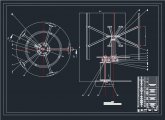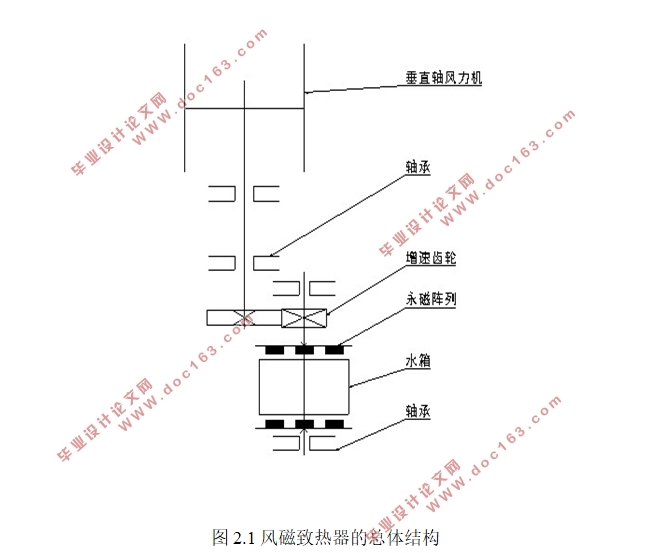基于涡流法的风磁致热器设计(含CAD零件装配图)

基于涡流法的风磁致热器设计(含CAD零件装配图)(任务书,开题报告,外文翻译,论文说明书14000字,CAD图5张)
摘 要
目前,随着世界的快速发展,化石能源开始被过度开采使用,化石能源危机已经到来,故需要大力开发对新能源的利用。而风能致热是国内近些年发展的新的风能的利用形式,风力致热的能量利用率高,对于风的变化适应性更加良好,主要的是风力致热装置的结构相比其它能量转化装置要简单,能够更好的运用于生活,具有很好的前景与潜力。
为此,本文旨在设计一种能够有效将风能转化为热能的能量转换装置,完成装置整体结构的设计,确定垂直轴风力机的型号与参数。使用Solidworks三维机械设计软件完成风磁致热器的建模,使用Ansoft Maxwell电磁场分析软件对Halbach永磁阵列进行仿真分析,仿真结果显示各项指标满足设计要求。本文对此类型的风磁致热器的进一步研发,提供了一部分理论依据。
关键词:涡流法 风磁致热 垂直轴风力机 Halbach永磁阵列
Abstract
At present, with the rapid development of the world, fossil energy has begun to be over-exploited and the fossil energy crisis has come. Therefore, it is necessary to vigorously develop the use of new energy. The wind-induced heat is a new form of wind energy that has been developed in recent years in China. The energy efficiency of wind-induced heat is high, and the adaptability to wind changes is better. The main point is that the structure of wind-heating devices is compared with other energy conversions. The device should be simple and can be applied to life better. It has good prospects and potential. [资料来源:www.doc163.com]
Therefore, this paper aims to design an energy conversion device that can effectively convert wind energy into heat energy, complete the design of the overall structure of the device, and determine the model and parameters of the vertical axis wind turbine. The three-dimensional mechanical design software of Solidworks was used to complete the modeling of the wind-heating heater. The Halbach permanent-magnet array was simulated using Ansoft Maxwell electromagnetic field analysis software. The simulation results showed that the indicators met the design requirements. This article provides some theoretical basis for the further development of this type of wind-magnetic heater.
Keywords:Eddy-current method Wind magnetic heating Vertical axis wind turbine Halbach permanent magnet array
2.1 风磁致热器的总体结构
风磁致热器的总体结构可以分为三个部分:分别是风力机部分、齿轮增速部分与涡流致热部分。
2.2风磁致热器的工作原理
风磁致热器的工作原理是:其基本工作原理是电磁感应定律,具体来说首先选用风力机作为驱动装置,驱动力的来源即为风能,风力机在风力的带动下旋转,再经过齿轮增速机构,带动转子盘旋转,由于转子盘上粘贴的有永磁体,故在转子盘与定子加热板之间存在磁场,从而定子加热板会产生感应电流,达到产生热量的目的。
[资料来源:http://doc163.com]
[资料来源:http://doc163.com]



目录
摘要 3
Abstract 4
第1章绪论 1
1.1 引言 1
1.2 风能致热发展概述 1
1.2.1 风力致热的方式 1
1.2.2 国外研究现状 3
1.2.3 国内研究现状 4
1.3 论文内容安排 4
第2章风磁致热器的总体结构 6
2.1 风磁致热器的总体结构 6
2.2 风磁致热器的工作原理 6
2.3 风力机的基本理论与设计方法 7
2.3.1 风力机的类型 7
2.3.2 H型垂直轴风力机的选型过程 7
2.3.3 H型垂直轴风力机结构综述 8
2.3.4 H型垂直轴风力机零部件校核 9
2.4 齿轮增速结构的基本理论与设计方法 9
2.4.1 增速齿轮结构的设计过程 10
2.4.2 增速齿轮结构综述 11
2.5 本章小结 11
第3章永磁涡流致热结构致热原理 12
3.1 永磁涡流致热结构的基本物理原理 12
3.1.1电磁感应定律 12
3.1.2 涡流现象 13
3.1.3 涡流的趋肤效应与趋肤深度 14
3.2 永磁涡流致热结构综述 15 [资料来源:http://Doc163.com]
3.2.1 永磁涡流致热结构的工作原理 15
3.2.2 永磁涡流致热结构 15
3.3 永磁涡流致热结构发热功率影响因素 15
3.4 Maxwell软件静磁场分析基础 16
3.5 不同气隙宽度的永磁涡流致热结构的静磁场有限元分析 16
3.5.1 模型建立 16
3.5.2 建立求解器与求解域 17
3.5.3 添加材料 17
3.5.4 边界条件设置 18
3.5.5 求解计算 19
3.5.6 计算结果 19
3.5.7 结论分析 22
3.6 不同极距的永磁涡流致热结构的静磁场有限元分析 22
3.6.1 模型建立 22
3.6.2 计算结果 22
3.6.3 结论分析 24
3.7 不同磁极对数的永磁涡流致热结构的静磁场有限元分析 25
3.7.1 模型建立 25
3.7.2 计算结果 25
3.7.3 结论分析 26 [版权所有:http://DOC163.com]
3.8 本章小结 26
第4章风磁致热器的效益分析 28
4.1 风磁致热器发热效率计算 28
4.1.1输入风能的计算 28
4.1.2输出热能的计算 28
4.1.3能量转换效率的计算 29
4.2 本章小结 29
第5章总结与展望 30
5.1 总结 30
5.2 展望 30
参考文献 31
致谢 32 [版权所有:http://DOC163.com]
上一篇:基于力控制技术的汽车铸锻件机器人磨抛工艺技术研究(含CAD图,SolidWorks三
下一篇:共享单车智能泊车机器人结构设计与分析(含CAD图,SolidWorks三维图)
